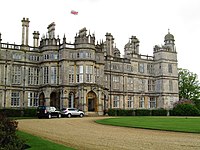Burghley House
It is a leading example of the Elizabethan prodigy house, built and still lived in by the senior (Exeter) branch of the Cecil family and is Grade I listed.
The house is open to the public on a seasonal basis[2] and displays a circuit of grand and richly furnished state apartments.
[3] The house is on the boundary of the civil parishes of Barnack and St Martin's Without in the Peterborough unitary authority of Cambridgeshire.
1947), antiques expert and television personality, followed her father, Olympic gold medal-winning athlete, IAAF President and MP, David Cecil, the 6th Marquess, by running the house from 1982 to 2007.
[12] The house is one of the main examples of stonemasonry and proportion in sixteenth-century English Elizabethan architecture, reflecting the prominence of its founder, and the lucrative wool trade of the Cecil estates.
Although the house was built in the floor plan shape of the Letter E, in honour of Queen Elizabeth, it is now missing its northwest wing.
During the period of the 9th Earl's ownership, and under the guidance of the famous landscape architect, Capability Brown, the south front was raised to alter the roof line, and the north-west wing was demolished to allow better views of the new parkland.
Although depleted of a number of important pieces by death duties in the 1960s, the Burghley art collections are otherwise mainly intact and are very extensive.
John Cecil purchased 300 works of art during his 22 years in Burghley and spent on his last visit to Europe £5,000 (c. £600,000 in 2017 currency[17]).
The avenues in the park were all laid out according to the 1755–1779 designs by Capability Brown,[22] paying due respect to pre-existing plantings, some of which were from the 16th century or earlier.
He discovered a seam of waterproof "blue" clay in the grounds, and was able to enlarge the original nine-acre (36,000 m2) pond to the existing 26-acre (105,000 m2) lake.
Data before the COVID-19 pandemic in the United Kingdom indicated that the number of visitors to the site each year had almost doubled during Miranda Rock's tenure, to 110,000.
[36] One of the more curious and prominent features of the house, is the presence of fourteen green sea turtle (Chelonia mydas) skulls on the wall in the kitchen.











